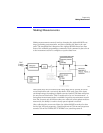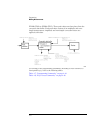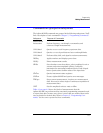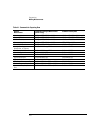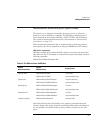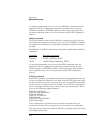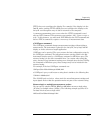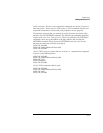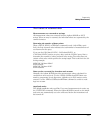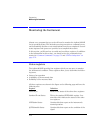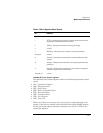
4-12
Programming
Making Measurements
Always force the Agilent 86120B to wait for non-sequential com-
mands
The Agilent 86120B normally processes its remote programming commands
sequentially. The instrument waits until the actions specified by a particular
command are completely finished before reading and executing the next com-
mand. However, there are a few non-sequential commands where this is not
true. Non-sequential commands do
not
finish executing before the next com-
mand is interpreted.
The following is a list of the Agilent 86120B’s non-sequential commands:
:CALCulate1:TRANsform:FREQuency:POINTs
:CALCulate2:PEXCursion
:CALCulate2:PTHReshold
:CALCulate2:WLIMit:STATe
:CALCulate2:WLIMit:STARt:FREQuency
:CALCulate2:WLIMit:STARt:WAVelength
:CALCulate2:WLIMit:STARt:WNUMber
:CALCulate2:WLIMit:STOP:FREQuency
:CALCulate2:WLIMit:STOP:WAVelength
:CALCulate2:WLIMit:STOP:WNUMber
:CALCulate3:SNR:AUTO
:SENSe:CORRection:ELEVation
:INITiate:CONTinuous
:INITiate[:IMMediate]
The following additional commands are also non-sequential commands if
CALCulate3:SNR:AUTO is set to OFF:
:CALCulate3:REFerence:FREQuency
:CALCulate3:REFerence:WAVelength
:CALCulate3:REFerence:WNUMber
The benefit of non-sequential commands is that, in some situations, they can
reduce the overall execution times of programs. For example, you can set the
peak excursion, peak threshold, and elevation and use a *WAI command at the
ARRay and the SCPI standard
According to the SCPI command reference, ARRay command causes an instrument to
take multiple measurements. (A <size> parameter indicates the number of measure-
ments to take.) However, the Agilent 86120B’s ARRay command refers to the measure-
ments performed for one measurement sweep; this results in an array of measured
signals. Because the <size> parameter does not apply, any <size> parameter sent will be
ignored by the instrument. No syntax error will be generated if a <size> parameter is
sent.




